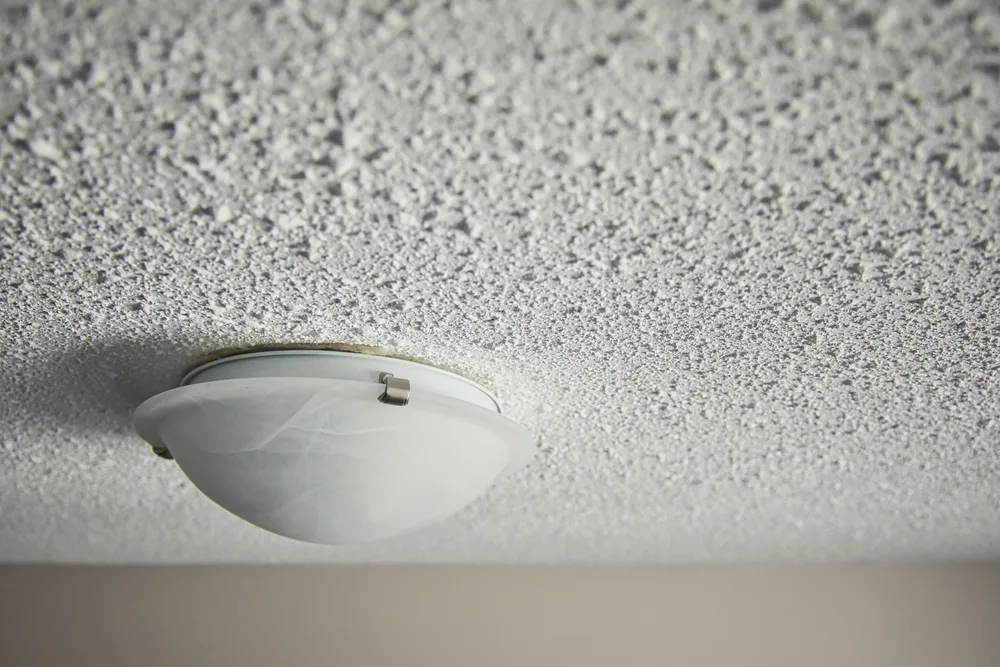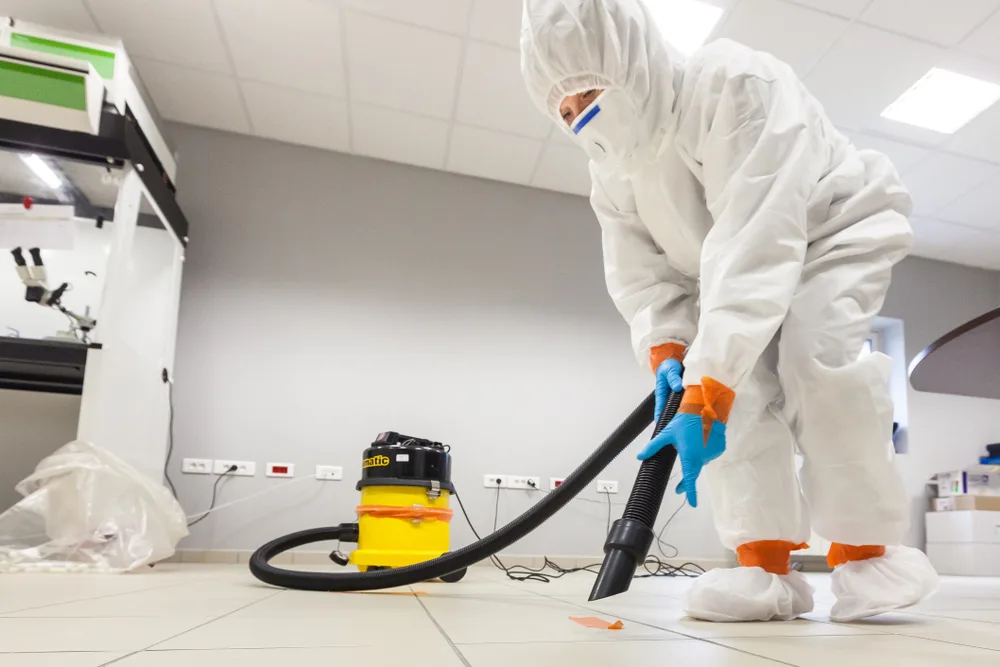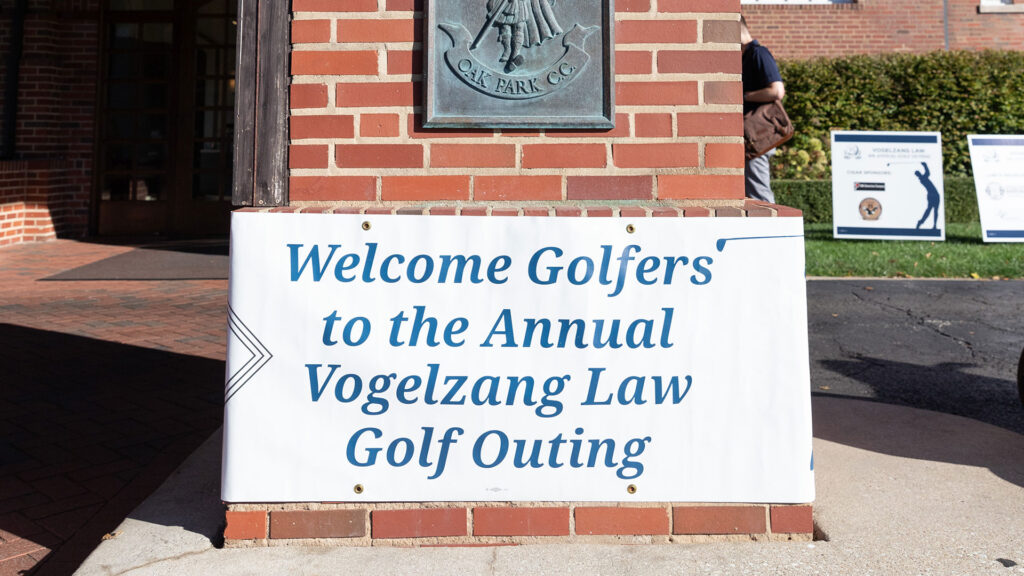Popcorn ceilings, once a popular home decor choice, have now become a source of concern for many homeowners and renters due to their potential to contain asbestos.
These textured ceilings, often found in homes built between the 1950s and the early 80s, were favored for their ease of application and noise-damping abilities. However, the discovery of asbestos in popcorn ceilings has led many to question their safety.
As a law firm that tirelessly works for victims of asbestos exposure, Vogelzang Law is here to shed light on this issue. Our dedicated team of asbestos and mesothelioma attorneys has years of experience handling asbestos-related cases, working relentlessly for our clients’ justice and compensation.
Aside from our mission to seek justice for asbestos exposure victims, we also strive to provide actionable insights to protect your health and your rights. At Vogelzang Law, your well-being is our most profound commitment.
The Historical Use of Asbestos in Popcorn Ceilings

A significant contributing factor to the widespread use of these ceilings was the incorporation of asbestos. Known for its fire-retardant properties, durability, and versatile usage, asbestos was often added to the popcorn ceiling mixture to improve its insulating capacity. This addition aided notably in making homes safer from fire hazards, a major concern in that era.
For decades, manufacturers used asbestos-containing material in popcorn ceilings and a broad range of other consumer products before asbestos was recognized as a toxic substance.
The use of asbestos in popcorn ceilings and many other building materials ceased after it was linked to serious health problems. In the Clean Air Act of 1978, the U.S. banned asbestos-containing materials that could be sprayed on surfaces, which included most popcorn ceiling mixtures.
Although this law went into effect, it’s worth mentioning that contractors and stockists were allowed to use up their existing stocks. This exemption implies that popcorn ceilings up to the mid-80s could potentially contain asbestos.
Today, the presence of asbestos in popcorn ceilings of older buildings and homes is a major point of concern due to the health risks associated with asbestos exposure. Popcorn ceilings contained asbestos if installed before 1980, highlighting the potential health risks. It is this potential danger that requires our attention and proactive legal steps to ensure the safety and well-being of residents.
The Risks of Asbestos Exposure
The presence of asbestos in popcorn ceilings, especially in older homes, becomes particularly concerning when considering the severe health risks associated with asbestos exposure.
The most known and hazardous diseases caused by asbestos exposure include mesothelioma, lung cancer, and asbestosis.
-
Lung Cancer: Asbestos fibers, when inhaled, can lodge in the lung tissues, leading over time to genetic changes in the cells and eventually lung cancer. Asbestos-related lung cancer is often indistinguishable from the type caused by smoking and other causes.
-
Mesothelioma: This rare form of cancer affects the thin lining of the body’s internal organs, most commonly the lungs. Mesothelioma is almost exclusively caused by asbestos exposure.
-
Asbestosis: This is a chronic lung disease caused by the inhalation of asbestos fibers that lead to scarring of the lung tissues, which restricts breathing. Asbestosis doesn’t always progress to cancer, but it significantly impairs quality of life and increases the risk of malignant changes.
Asbestos popcorn ceilings pose significant health risks, and professional removal services are essential to ensure safe handling and mitigation of these hazards. Managing asbestos particles during removal and abatement procedures is crucial to prevent them from becoming airborne.
Even short-term exposure to asbestos can pose a risk, although typically, the severity of diseases depends on the duration and intensity of exposure. Disturbing or deteriorating popcorn ceilings increase the risk of exposure.
If you or a loved one was exposed to asbestos, you can pursue compensation for the pain, suffering, and financial burden arising from asbestos-related diseases.
How to Identify Asbestos in Your Ceiling
If you suspect you have an asbestos popcorn ceiling, identify it as early as possible to mitigate exposure risks. However, the challenge lies in the fact that asbestos cannot be identified by appearances alone.
Asbestos is a microscopic fibrous material and cannot be seen with the naked eye in a product or material, such as popcorn ceiling textures. It’s not possible to discern the presence of asbestos in your popcorn ceiling just by looking at it.

The only surefire way to determine whether your ceiling contains asbestos is to have a sample tested by an accredited laboratory. Generally, a small sample of the popcorn ceiling is collected following specific safety protocols to prevent asbestos dust and fiber release. The collected sample goes a lab where it undergoes analysis to identify if it contains asbestos.
Given the potential hazard of asbestos exposure, even in small quantities, it’s advisable not to collect the sample yourself. Instead, hire a qualified professional to ensure the process is safely and accurately executed.
Ultimately, if you have a popcorn ceiling and you suspect it may contain asbestos, don’t try to handle it yourself—especially if the ceiling is damaged or you’re planning to remodel.
Proper handling of an asbestos-containing popcorn ceiling during any future remodeling activities is crucial to prevent asbestos fibers from escaping. Instead, hire asbestos removal professionals to safely remove popcorn ceilings and ensure an asbestos-free environment.
Even minor disruptions to an asbestos popcorn ceiling can release asbestos fibers into the air and pose a risk to your health. Instead, engage the expertise of professionals and consider legal counsel to protect your rights if exposure has already occurred.
What to Do After Asbestos Exposure
The realization that you may have been exposed to asbestos, particularly within the supposed safety of your own home or workplace, can be distressing. Beyond the health concerns that such exposure stirs, there is often the accompanying sense of injustice, especially if the exposure was due to the negligence or irresponsibility of others. Thankfully, there exist legal avenues to help rectify these situations.
In the unfortunate situation that you or a loved one has developed an asbestos-related disease due to exposure, you may be eligible for legal compensation. Asbestos exposure cases often constitute a form of personal injury lawsuit.
However, these complicated cases require a profound understanding of medical details, regulatory standards, and the ability to draw a direct link between exposure and diseases. This complexity is why you need an experienced law firm that handles asbestos-related cases.
At Vogelzang Law, we are committed to fighting for the rights of asbestos exposure victims. We understand the devastation brought about by asbestos-related diseases, and our commitment goes beyond just securing financial compensation. We see ourselves as your trusted partners, standing by you in these trying times as you focus on your health and well-being.
Remember, while every case is unique, our steadfast commitment to fight for the welfare of our clients remains unwavering. Exposure to asbestos is not your fault; you shouldn’t bear the brunt of the health and financial consequences. We’re here to help you seek the justice and compensation you deserve. Contact us or call (312) 466-1669 today for more information about your legal rights following asbestos exposure.



